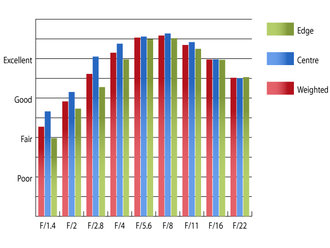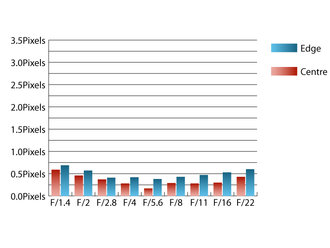Samyang 24mm f/1.4 ED AS IF UMC Lens Review
Samyang 24mm f/1.4 ED AS IF UMC Performance
At f/1.4, this lens will not win any awards for sharpness, but the fairly good centre sharpness should be just decent enough for small sizes on the web, or even video work. Stopping the aperture down improves sharpness dramatically, with good sharpness being achieved in the centre by f/2 and excellent centre clarity at f/2.8. Sharpness towards the edges of the frame lags behind somewhat, only reaching good levels at f/2.8, but still improves as the lens is stopped down. Peak sharpness across the frame is achieved between f/5.6 ad f/8, where the clarity produced approaches outstanding levels across the frame. Resolution at 24mm | How to read our chartsThe blue column represents readings from the centre of the picture frame at the various apertures and the green is from the edges. Averaging them out gives the red weighted column.The scale on the left side is an indication of actual image resolution. The taller the column, the better the lens performance. Simple. For this review, the lens was tested on a Nikon D700 using Imatest. |
Chromatic aberrations are kept under control, remaining under half a pixel width in size at all but the fastest and slowest apertures. These low levels of fringing should pose few issues in the field.
Falloff of illumination towards the corners is very strong. The corners are three stops darker than the image centre at f/1.4 and visually uniform illumination isn't achieved until the aperture is stopped down to f/8 or beyond.
 Chromatic aberration at 24mm | How to read our chartsChromatic aberration is the lens' inability to focus on the sensor or film all colours of visible light at the same point. Severe chromatic aberration gives a noticeable fringing or a halo effect around sharp edges within the picture. It can be cured in software.Apochromatic lenses have special lens elements (aspheric, extra-low dispersion etc) to minimize the problem, hence they usually cost more. For this review, the lens was tested on a Nikon D700 using Imatest. |
Imatest detected 2.03% barrel distortion, which is a relatively mild amount for a wide aperture lens like this, but may still become visible in images with straight lines close to the edges. The distortion pattern is uniform across the frame, so should be relatively straightforward to correct in image editing software afterwards.
The multi coatings applied to this lens seem quite effective, suppressing flare and keeping contrast levels reasonable. Strong point sources of light shining into the lens will cause a loss of contrast and plenty of ghosting, but only in extreme examples of this kind of lighting.
Add your message
Login required
Please login here or if you've not registered, you can register here. Registering is safe, quick and free.
Please login here or if you've not registered, you can register here. Registering is safe, quick and free.
photodo Stats
1102 lenses
428 MTF tests
74 in-depth photodo reviews
100+ users join each day
Help the lens community by reviewing or rating a lens today via our lens search
428 MTF tests
74 in-depth photodo reviews
100+ users join each day
Help the lens community by reviewing or rating a lens today via our lens search
Latest Lens Reviews
- Chinon 28mm f/2.8 Vintage Lens Review
- Canon EF 70-200mm f/4L IS II USM Lens Review
- Samyang AF 85mm f/1.4 EF Review
- Sigma 70mm f/2.8 DG Macro Art Review
- Samyang AF 24mm f/2.8 FE Review
- Meike 50mm f/1.7 Review
- Tamron 70-210mm f/4 Di VC USD Review
- Lensbaby Burnside 35mm f/2.8 Review
- Asahi Super Takumar 50mm f/1.4 Review
- Asahi Super-Multi-Coated Takumar 135mm f/3.5 Review
